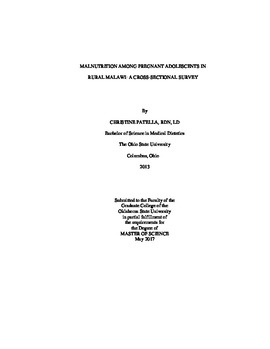| dc.description.abstract | The high rates of adolescent pregnancies in Malawi challenge the health and nutritional status for mothers and their babies. When an adolescent is pregnant, there is competition for nutrients and energy between her own developing body and the growing baby. If an adolescent is unable to meet her own nutritional needs, this may lead to a continued cycle of nutritional complications. In general, research focusing pregnant adolescent nutrition in Malawi is lacking. Therefore, the purpose of this study was to assess dietary diversity and the prevalence of malnutrition in pregnant adolescents in rural Malawi. The study included sixty-two pregnant adolescents between 15-19 years old. The mean (SD) age of the subjects was 17.7 (1.2) years old. The majority of the subjects were married (84%), not currently enrolled in school (98%), and not working outside of the home (92%). For 88% of the subjects, this was their first pregnancy. A questionnaire and standardized dietary diversity survey was used. Mid-upper arm circumference (MUAC), height, weight, and hemoglobin were measured. The mean (SD) MUAC was 25.89 cm (1.99) and 31% were classified as having low MUAC (<25 cm). The mean (SD) height-for-age z-score was -1.28 (0.82), 19% of the subjects were stunted and 21% were ?150 cm tall. The mean hemoglobin was 10.37 g/dL and 66% of the subjects had anemia. The mean (SD) minimum diet diversity score (MDD-W) was 4.06 (1.18) and 69% did not meet the minimum dietary diversity-women (? 5 of the 10 recommended food groups). The majority of the subjects were not taking any antenatal supplements (63%) and only 37% were taking ferrous sulfate. Food restrictions during pregnancy were common (35%). Nearly half of the subjects had not received advice about what to eat during pregnancy and 92% had not received advice about infant and young child feeding practices. Consuming pulses, beans, and lentils predicted a 2.88 kg decrease in weight (p=0.0393). Consuming meat and poultry or dark leafy green vegetables predicted a 1.31 and 1.08 increase in hemoglobin levels, respectively. The likelihood of stunting increased as the number of individuals in the household increased [AOR=1.42 (1.05-1.90), p=0.0120]. As the number of antenatal visits increased, the likelihood of taking a supplement and receiving food advice increased [AOR=6.24 (2.03-19.18), p<0.0001), [OR=19.33(4.72-79.22), p<0.0001]. Interventions for pregnant adolescents should include nutrition education on dietary diversity, foods to increase hemoglobin, taking antenatal supplements and infant and young child feeding practices. | |
